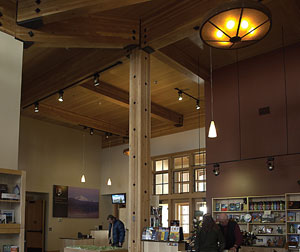The Future Looks Bright: Energy-Efficient Lighting Technologies
Digital Advances in Controls
For major lighting installations and retrofits, project teams should look for advanced digital control strategies and systems, which offer distinct advantages over older, analog systems. "Digital control systems enable ladderless and toolless startup, calibration and commissioning," says Craig DiLouie, education director with the Lighting Controls Association, Rosslyn, VA. "They can consolidate the power switches for a load to a single relay that, in turn, is controlled by a programmable or adjustable control/logic card. This allows easy, simplified and cost-effective integration of multiple control inputs."
Some systems even enable configuration via handheld tools on site, while others work with an Internet connection and some even configure themselves, albeit to varying degrees of accuracy. Many of the packages are able to self-configure the entire lighting system, says Horton, including all the system controllers, occupancy sensors, switches, daylighting sensors, plug-load controls, lightingcontrol panels, interfaces and accessories. Lighting designers like Mor encourages clients to run automatic configuration programs but also to fine-tune settings during commissioning.
The fact remains that lighting systems, especially large ones, can be extremely complex, involving literally thousands of digital addresses. The cost of commissioning such a monster can be very steep and time-intensive, not to mention future changes to the lighter loads. "Manually, this can become unmanageable, as the complexity of the system becomes impossible to comprehend, and the manually mapped documentation becomes confused or lost," says Willmorth.
Faithfully addressing this technical nightmare, "automatic" systems can do much to simplify this process as this complex data is embedded into the system's architecture. Consequently, setting the levels becomes a matter of pointing and clicking. And when a luminaire burns out, the system will automatically assign the same control association with the new bulb, so there's potentially no commissioning impact.
However, one drawback is the lack of replacement parts currently available for these advanced systems. "This means that some lighting systems end up a hybrid of the manual and automatic, which can be a little messy," cautions Willmorth.
Unfortunately, a similar limiting-type situation applies to the Digital Addressable Lighting Interface. While the original goal was to create an open protocol, says DiLouie, "The standard suffered from complex commissioning requirements, lack of definition for communication between controls and relatively slow data transmission speed. As a result, manufacturers have moved ahead on their own and now offer packaged, proprietary-protocol systems," explains DiLouie.
Consequently, users often find themselves locked into a single manufacturer for technical support and future component replacements. For this reason, some designers, such as Brett Lorenzen, a LEED-accredited electrical engineer-in-training with SmithGroup in Phoenix, prefer nonproprietary digital distributedcontrol systems.
| National Parks Service Chooses LED Track Lighting | ||
Lassen Volcanic National Park has long offered beautiful views and scenery 160 miles west of Reno, Nevada, but until recently it never had a visitor facility. After a 92-year wait since opening, the park now has the Kohm Yah-mah-nee Visitor Center at its Southwest entrance.
The U.S. National Park Service (NPS) elected to make the facility LEED Platinum, and included integrated daylighting and electrical lighting systems as well as a novel LED track lighting system supported on a field-bendable monorail. The LED track system employs 50 luminaires to illuminate roughly 1,500 square feet of displays, kiosks and historic photos. "Through the use of this new LED-based track lighting system, the visitor center exhibits will be using less than half of the energy required by similar halogen-based lighting systems," says Ric Alesch, NPS project manager. The track system is controlled by a digital dimming system that adjusts light levels in the exhibit based on the amount of natural daylight entering the space through picture windows on the facility's north façade. According to Journée Lighting, which manufactures the track system, the LED-based light fixtures comply with California's energy-conscious Title 24 code as well as U.S. Green Building Council LEED standards being adopted nationwide. Before using the LED track fixtures for the exhibit area, NPS officials monitored the same system's performance at the agency's Harpers Ferry Center in West Virginia. An exhibit lighting consultant confirmed that the fixtures drew only 16 watts while producing luminance equivalent to a 40-watt incandescent bulb. In addition, unlike other high-efficiency light sources such as compact fluorescent and metal halide, the LED sources contain no mercury or lead and offered a long rated lamp life of about 40,000 hours. The product evaluation also showed that the luminaires would help the Visitor Center meet or exceed platinum LEED certification. |










